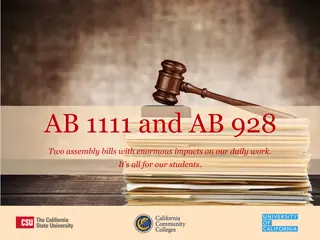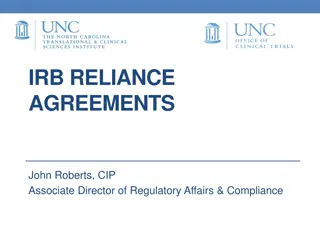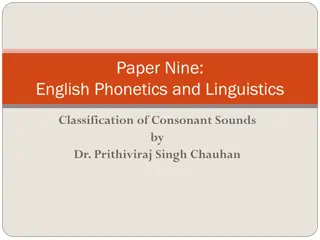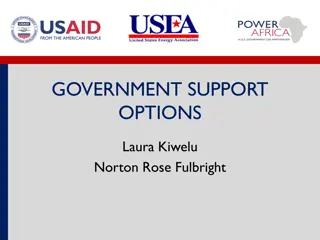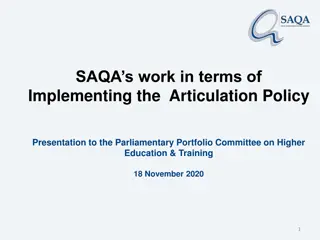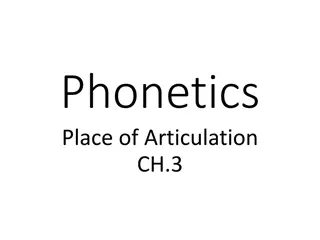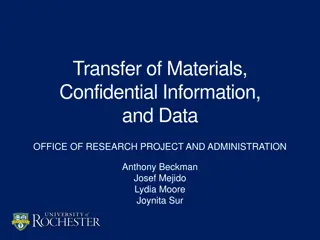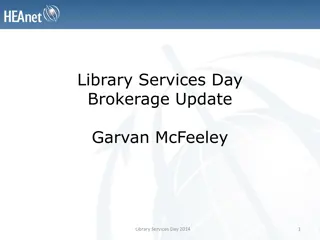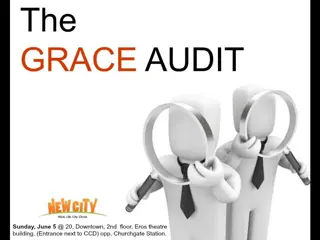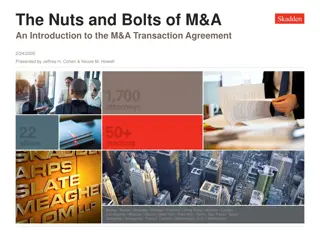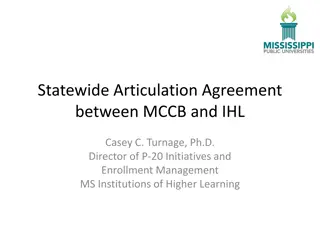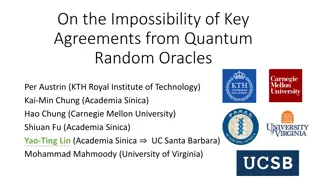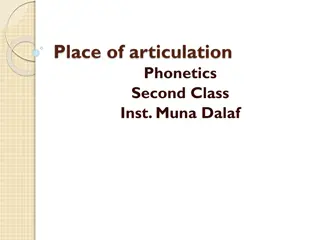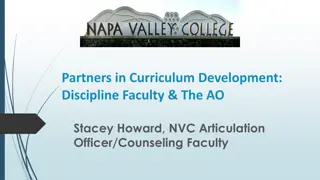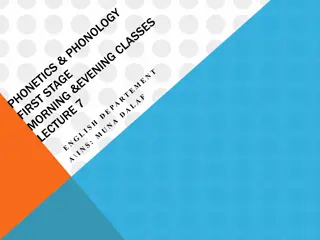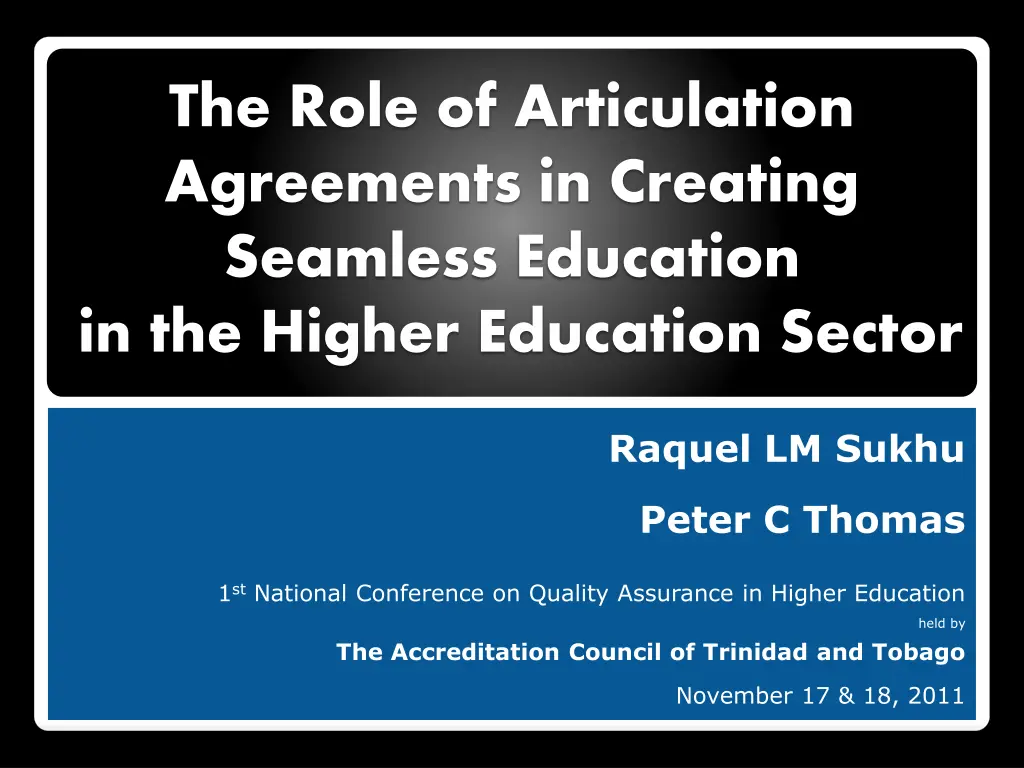
Articulation Agreements for Seamless Education in Higher Education Sector
Explore the role of articulation agreements in creating seamless education in the higher education sector. Learn about strategies, challenges, benefits, and best practices associated with promoting seamless transitions in education through these agreements.
Download Presentation

Please find below an Image/Link to download the presentation.
The content on the website is provided AS IS for your information and personal use only. It may not be sold, licensed, or shared on other websites without obtaining consent from the author. If you encounter any issues during the download, it is possible that the publisher has removed the file from their server.
You are allowed to download the files provided on this website for personal or commercial use, subject to the condition that they are used lawfully. All files are the property of their respective owners.
The content on the website is provided AS IS for your information and personal use only. It may not be sold, licensed, or shared on other websites without obtaining consent from the author.
E N D
Presentation Transcript
The Role of Articulation Agreements in Creating Seamless Education in the Higher Education Sector Raquel LM Sukhu Peter C Thomas 1stNational Conference on Quality Assurance in Higher Education held by The Accreditation Council of Trinidad and Tobago November 17 & 18, 2011
Articulation agreements are the bridge to seamless education through lifelong learning (Josey, 2009) Powerpoint Templates Powerpoint Templates Page 2
Objectives Define seamlessness in education Identify seamlessness strategies to achieve Examine articulation agreements as a strategy within HE Highlight challenges key issues, benefits and Review best practices Powerpoint Templates Powerpoint Templates Page 3
Seamlessness in education Coordination of smooth transition between ECCE, secondary education systems primary & An integrated concept of education stretching from through a college/university degree early childhood four-year Educational institutions content preparation without among break a in Powerpoint Templates Powerpoint Templates Page 4
Strategies towards Seamlessness Prior learning assessment & recognition (PLAR) School-to- work programmes Dual credit programmes Common general education core Common course numbering Qualifications and credit framework Integrated student unit record data system Articulation agreements Powerpoint Templates Powerpoint Templates Page 5
Articulation generally institutional policies or other structures that are implemented facilitate and monitor transfer process understood to mean the to encourage, the student refers to the mechanisms that enable student mobility within and among the institutions that comprise system the tertiary Powerpoint Templates Powerpoint Templates Page 6
Articulation the process of coordinating curricula at different levels of education in order to foster the efficiency and effectiveness of the educational process which is used as a vehicle to encourage between educational institutions collaboration Powerpoint Templates Powerpoint Templates Page 7
Articulation Through articulation, one institution are recognised by another, allowing students standing in a new programme credentials from to attain post advanced secondary Powerpoint Templates Powerpoint Templates Page 8
Articulation Articulation concept of transfer the process of moving a student s credits across different institutions is closely linked to the Numerators of the transfer rate tend to be focused on student transfer, and not transfer of credits Powerpoint Templates Powerpoint Templates Page 9
Articulation The intention of articulation policies (in the US context) transfer rates is not to improve it is to prevent the loss of credits when students transfer. Powerpoint Templates Powerpoint Templates Page 10
Articulation Student movement is multi-directional: Vertical upwards or downwards (reverse) Lateral between similar institutions Swirlers frequently alternating between two- and four-year institutions Powerpoint Templates Powerpoint Templates Page 11
Articulation Agreements United States 100 year history of articulation; state- wide agreements South Australia integration of PLAR, articulation with TAFE South East Asia - pathways for technical and vocational education graduates Powerpoint Templates Powerpoint Templates Page 12
Articulating in Trinidad & Tobago A number of HEIs have established agreements Scholarship on the need for seamlessness and articulation Guidelines for Framing Articulation Agreements in Trinidad and Tobago Powerpoint Templates Powerpoint Templates Page 13
Key Issues Differentiation and diversification The binary divide Drift (academic; vocational) Ensuring mobility, inclusive of swirlers and reverse articulation Powerpoint Templates Powerpoint Templates Page 14
Benefits of High Articulation FOR STUDENTS 1. Improved access and freedom of movement 2. Lower rates of drop-out or failure without credit 3. Increased programme choice 4. Less wastage time, endeavour, money Powerpoint Templates Powerpoint Templates Page 15
Benefits of High Articulation FOR STUDENTS 5. The possibility of non-traditional learning experiences being credited towards a degree 6. Opportunities to change concentrations or institutions mid- stream, or to delay final choices whilst still carrying forward relevant credits Powerpoint Templates Powerpoint Templates Page 16
Benefits of High Articulation FOR STUDENTS 7. Possibility of moving between institutions in accordance with aspirations 8. Opportunities to pursue lifelong learning through the flexible accumulation of credits over a long or short time period Powerpoint Templates Powerpoint Templates Page 17
Benefits of High Articulation FOR INSTITUTIONS 1. Effective means of facilitating equity under conditions of inter- and intra- institutional differentiation 2. Possibility of greater interdisciplinary programme linkage across institutions 3. Fewer repeaters and drop-outs Powerpoint Templates Powerpoint Templates Page 18
Benefits of High Articulation FOR INSTITUTIONS 4. Less curriculum duplication / overlap 5. Increased academic collaboration 6. Increased pass rates 7. Improved internal institutional efficiency along with the possibility of increasing student numbers Powerpoint Templates Powerpoint Templates Page 19
Best Practice Seven Guiding Principles 1. Parity among institutions 2. Parity of students 3. Faculty have primary responsibility for crafting agreements 4. Accommodate students without a minimum of associate degree transfer Powerpoint Templates Powerpoint Templates Page 20
Best Practice Seven Guiding Principles 5. Agreements in specific programme majors as well programme major courses 6. Both public and private institutions should participate 7. Data-driven performance of agreements as transfer of evaluation of Powerpoint Templates Powerpoint Templates Page 21
In conclusion The articulation agreement is a key mechanism upon development of a seamless HE system in Trinidad & Tobago is dependent and as participants in the HE system we must begin to critically evaluate the ways in which we build and employ them. which the Powerpoint Templates Powerpoint Templates Page 22
In conclusion Differentiated and diversified HE systems with articulation will, fragmented systems, seamless. insufficient best, far at be from Powerpoint Templates Powerpoint Templates Page 23
Thank you! Powerpoint Templates Powerpoint Templates Page 24

